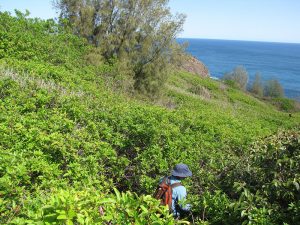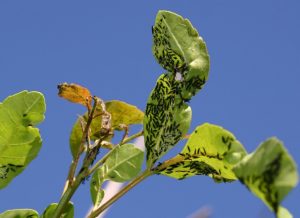THE TARGET: Christmas berry (Schinus terebinthifolia)

Christmas berry infestation; Photo by Forest & Kim Starr
- Christmas berry is one of the most aggressive and widespread invasive species in the Hawaiʻi with its ability to dominate mesic forests, threaten agriculture and cattle production, and decrease biodiversity of natural areas. It outcompetes natives for water resources and has been shown to suppress growth of native species by producing allelopathic compounds, threatening native host plants and habitats of endangered plant and animal species. Biocontrol of Christmas berry in Hawaiʻi began in 1954, however, infestations remain so widespread throughout the state that chemical and mechanical control is not economically feasible.
- Distribution: In the State of Hawaiʻi, Christmas berry occurs on the islands of Hawaiʻi, Kauaʻi, Oʻahu, Lānaʻi, and Molokaʻi.
THE CANDIDATE: Pseudophilothrips ichini

Pseudophilothrips ichini attacking Christmas berry in Brazil
- Pseudophilothrips ichini is a thrips insect whose adults and larval stages feed on young leaves and stems of S. terebinthifolia, causing distorted growth and eventually death of the plant tip. Consistent attack on the growing terminal by the thrips should eventually reduce plant vigor and limit flower and seed production, and thereby reduce dispersal.
- Native range: Native to Brazil.
- Host testing results: Results of host specificity testing indicated that P. ichini is suitably host specific. The tests were conducted on 116 species from 45 plant families. Tests showed that P. ichini can only reproduce continuously and build up numbers on S. terebinthifolia so no negative population level effects are expected for any other species.
Project progress:
- Host specificity testing completed.
- Draft Environmental Assessment — Estimated publication in OEQC’s The Environmental Notice for public comment in Summer 2020.

